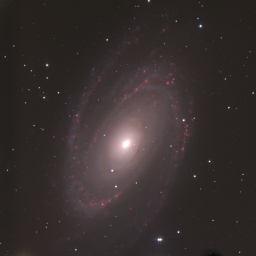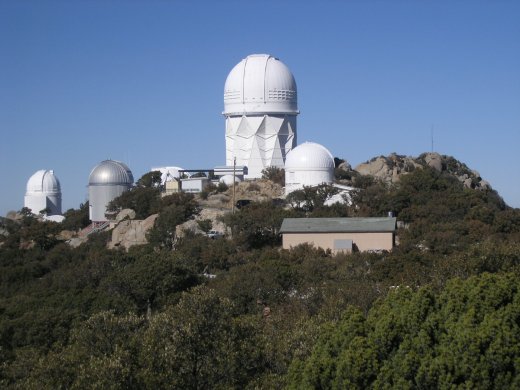Back from the mountain
Feb 3 2009, 23:23
Fernando and I are now back from Kitt Peak, after a largely successful observing run. In addition to monitoring V* NU Ori and V* LP Ori (the two magnetic stars discovered by Petit et al. 2008), we had a look at FN CMa for a night, to see if we could get a handle on some weird variability that Thomas Rivinius told me about recently. We'll have to see what the data show.
Because our science targets were in Orion and Canis Majoris, they set around 2:30am, three and a half hours before sunrise. We used some of this 'spare' time to undertake service observations, but for the rest we went after some pretty galaxies. The image to the right is a composite of M81, based on the Johnson BVR filters plus an Hα filter. The latter very nicely picks out the star-forming regions in the spiral arms of the galaxy. A full-sized version of the image can be grabbed here; kudos to John Barentine for assembling the image from its constituent parts while we were up on the mountain. Stay tuned for similar images of M82 and M104.
At the suggestion of Ryan Fox, one of my former
Astronomy 310 students, I've put together an RSS 2.0 feed for the news component of the website. I'm a bit of a n00b with RSS, and I found these instructions extremely useful in figuring out what I had to do.
The feed can be accessed via the item on the right-hand menu. I'd appreciate hearing any thoughts on whether the feed might benefit from a bit more content — for instance, a brief synopsis of each news story.
In other news: mad star is now using a completely rewritten parser. Internally, text is stored in a format very similar to that used by Wikipedia; the parser has the job of converting this text into XHTML, suitable for display on a web browser.
A theorist goes observing
Jan 31 2009, 07:39
Right now, I'm sat with Fernando Cardoso in the control room of the WIYN 0.9m telescope at Kitt Peak National Observatory. Although most of my research is theoretically oriented, I try to remain in touch with the experimental side of things — which leads me now and then to go off on an observing trip. This particular adventure came about due to 6 unscheduled nights on the 0.9m.
Fernando and I have mostly been undertaking differential CCD photometry of a couple of massive magnetic stars in Orion: V* NU Ori and V* LP Ori. The fields in these stars were only recently detected (see Petit et al. 2008), and we're looking to see whether the stars show the same sorts of periodic photometric variations as other, similar objects.
First light on Medusa
Jan 24 2009, 10:42
I've just completed my first successful set of calculations on Medusa, the new computer cluster that the Theory Group recently purchased. Medusa comprises 72 nodes of 8 AMD Opteron processors each, linked together with an InfiniBand networking fabric. There have been a few teething problems, but everything seems to be working OK now.
The test calculations involve Monte-Carlo simulation of radiative transfer through the electron-scattering magnetosphere of σ Ori E. I'm trying to reproduce the temporal variations in the star's linear polarization, originally observed by Kemp & Herman (1977). I've made some Stokes IQU images of the simulation results, and strung them together as a movie (AVI; MOV; movie help).
New paper: 'An Exact Integration Scheme for Radiative Cooling in Hydrodynamical Simulations'
Jan 20 2009, 15:19
The paper has just been accepted for publication in the Astrophysical Journal Supplement Series, and will be appearing in the August 2009 issue. It discusses a new method for implementing optically thin radiative cooling in hydro/MHD codes, which constitutes a big improvement over previous approaches. The method came to me when I was figuring out how to speed up cooling in VH-1; I had recently been reading a computer graphics article on speeding up Phong shading using look-up tables, and I realized that a similar approach could be used for the cooling calculation. The beauty of using look-ups is that they're not only fast, they're also exact.




